Growing Milkweed for the Monarch Butterfly
Milkweed – Monarch Butterfly Food Source
As a small family owned heirloom seed company, we receive many requests for partnerships with or donations to some great causes. Some of these are exceptional, as when the Xerces Society contacted us in January 2012 about growing a specific species of milkweed that is native to our part of central Arizona. Pollinators and pollinator attractants are very important to the success of any garden, so we jumped at the chance to connect the right people who share our passion for this project. Here is how that story unfolds!
Monarch butterflies have seen steady population declines across their native range since population monitoring first began in 1976. Several 2012 reports show that Monarch numbers will drop almost 30 percent this year, continuing a decline that has lasted for the past decade. The severe drought seen across Texas and Northern Mexico, combined with wildfires across the entire southwest has been a large factor. The biggest contributor is simply the loss of land that supports the Monarch’s food source and hatchery – the Milkweed plant. Much of the land has been converted to commercial herbicide tolerant corn and soybean production, or developed into housing. Overuse of persistent chemical herbicides and roadside mowing for weed control has also created loss of milkweed habitat and thus reduced Monarch numbers.
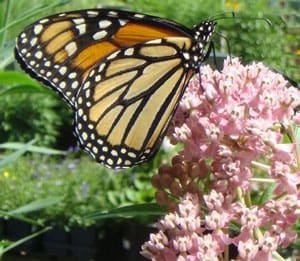
Monarch Butterfly on Milkweed
The milkweed plant (Asclepias spp.) plays a critical role in the monarch life cycle. Each spring Monarchs move across the United States, laying eggs on native milkweeds, the only plants that serve as food for newly hatched monarch caterpillars. Because of their migratory life cycle–breeding in the United States and Canada, and overwintering at only a few locations in Mexico and California–the most effective conservation strategies for Monarch butterflies are those that protect and restore habitat across their entire range. As a result, the North American Monarch Conservation Plan recommends planting native milkweed species to restore habitat within the Monarch butterfly’s breeding range.
The Xerces Society is working to increase the availability of native milkweed seed and encourage restoration using milkweed in California, the Great Basin, the Southwest, Texas, and Florida. These are important areas of the Monarch’s spring and summer breeding range where few commercial sources of native milkweed seed currently exist. To conduct the project, they are partnering with the Monarch Joint Venture, a coalition of federal and state agencies, scientists, and nonprofit conservation organizations.
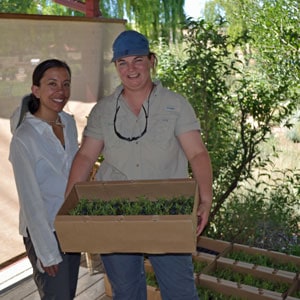
Brianna Borders and Cindy Scott with Milkweed plugs
At the end of this past January, we were contacted by Brianna Borders, Plant Ecologist for The Xerces Society about a possible project to propagate a subspecies of Milkweed – Asclepias asperula that is native to Arizona. She had about 2 ounces of seed (approximately 7,000 seeds) that had been collected in the southern portion of our local county by the Desert Botanical Garden volunteers in Phoenix. Through grant funding, a California native plant nursery could propagate the seeds into plugs ready for planting. The Xerces Society was looking for a grower in our area that could bring the project into being. This would be a minimum 2 year project to grow a commercial quantity of seed to offer for sale.
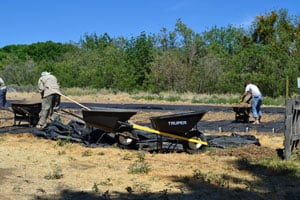
Spreading Mulch for Milkweed plugs
After some thought, we decided that Fiona Reid was the perfect fit for this project. Recently retired as Education Director from a natural history education center, she was already growing and saving milkweed seeds at her property – Painted Lady Vineyard! One of her passions is native plants of the area, with an emphasis on butterfly attractants, and has solid connections with the Arizona Native Plant Society, as well as the Desert Botanical Garden in Phoenix. The Painted Lady is a beautiful, ephemeral butterfly that happened to visit the vineyard in droves as the initial vines were being planted, thus the name for the vineyard came about.
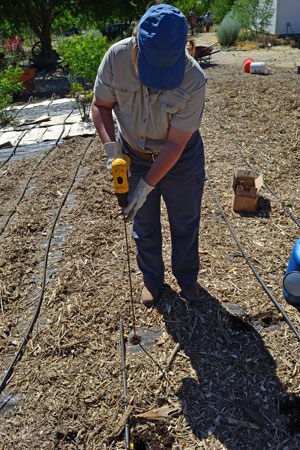
Drilling Holes for Milkweed Plugs
The planting took place over a long and extremely hot weekend in the middle of June after much work over many weeks not only by Fiona but her volunteer crew to prepare the ground to receive the fragile tiny plugs that had arrived overnight in flats from the grower in California. We took part in the planting, but what really inspired, amazed and humbled us was the outpouring of community support from all walks of life and all interests in this project that will only benefit the Monarch butterfly. There are no financial rewards for any of the volunteers for the hours spent bent over in 100 degree heat planting over 2,000 fragile plugs. Many of the people helping were native plant enthusiasts, some were butterfly lovers, but a significant number had no real interest besides that of helping see a project to fruition on nothing more than the basis of it is the right thing to do.

Planting Milkweed is a Team Effort
We received this email from Fiona on Monday after the planting weekend. When we left Saturday evening, a little over half of the plugs were planted. There was some concern of getting the rest planted with the remaining group and the high heat creating a deadline of viability for the milkweed plugs.
“Monday morning, after a pretty blazing hot weekend, and the little plants – ALL of them – are sitting in the ground, protected by mulch, and getting the necessary drink of water. Mission accomplished!
320 hours of volunteer labor, not even counting mine, to get this job done from start to finish. It has been an amazing community effort and I have had the pleasure of working with a great group of people, children included. As we began to close in on the finish yesterday, and everyone was hot and very dusty and sometimes muddy, I was almost overcome by the understanding that people don’t have to involve themselves in such hard work – sometimes backbreaking work, sometimes knee-breaking work, and always hot work. They could sit at home in the cool, or an office somewhere, and do good for someone else. But none of you did that. You came knowing it was going to be outside in the heat; knowing you would kneel and bend; knowing you would get dust in your nose and eyes; knowing that – as Rachel Carson said – “there is something beyond the bounds of our human existence” that matters. You also know that you won’t get any thanks from the butterflies that find all the little milkweed gardens that will eventually grow from this project. I do know, from the simple fact that you involved yourselves in this effort, that you will one day spot a monarch butterfly and in that fleeting moment there will be a part of your soul that stirs and feels absolute content. There is something right with the world – it may be ephemeral, and maybe you can’t articulate what it is, but that moment is enough for us.
I don’t think we will get a harvest this year at all. Next year we will have to put our heads together to figure out how we take the next step – collection of the seed. In the meantime I hope you can pat yourselves on the back for a fantastic job, so well done. I cannot thank you enough.”
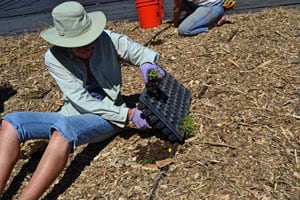
Planting Milkweed Plugs
Here’s Fiona’s update on the project after the Monsoon rains have begun:
“It’s what we have all been waiting for – the rains! Right now, as I look through my office window, there are heavy raindrops exploding like little bombs on the driveway, and I know they are doing just the same over the new milkweed fields less than a hundred yards away. Perhaps I should take this very opportunity to celebrate these first rains of the monsoon season and take off all my clothes and run over there and be like a little milkweed, totally open to the elements!”

Almost Half Way!
“2,190 milkweed plugs, grown from seed in a California greenhouse, are now at home in our native Skull Valley soil, barely 50 miles from their parent plants. And their roots are now moving out from the plug of soil which has been their ‘nest’ for so many months into the earth around them. These rains have showered them with nitrogen and freshness and their narrow leaves are pushing up towards the currently cloud covered sky. So I can pat myself on the back for a job well done, right? But nothing like this can happen without the help of others, so they all need a pat on the back as well.”
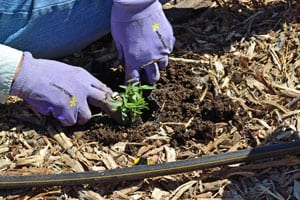
Busy Hands
“Community and connections make good things happen. Stephen and Cindy needed to think of me for this project; I needed Jodi Padgett, with whom I share life and land, to agree with the idea that we could plant the milkweed on the property; I needed to find someone to plough and level the planting areas; I needed volunteer help almost every step of the way. I needed Brianna Borders of the Xerces Society to support me when needed. Food and wine is usually a great incentive for volunteers, but that’s not all – realizing that there is, as Rachel Carson said, “something beyond the bounds of our human existence” worth paying attention to is probably more of an incentive for every single one of the volunteers who came and knelt, and dug, and laid weed barrier fabric, and connected irrigation parts, and invented hole-burners and augers, and finally, tenderly, popped these little milkweed plugs into the earth with a silent prayer that each one would grow strong. All of this work was done in unusually hot weather. The youngsters took much needed breaks by splashing around in the swimming pool; the elders sat in the shade gulping down iced mint tea. Everyone got hot, sweaty and very dusty.”

More Busy Hands
“And for the past month, as hot dry weather has continued to dominate our local area, I began and ended each day by watering those four blocks of milkweed. Today the rains did the watering for me, and moments ago, (fully clothed) I wandered around the blocks and, yes, all of a sudden it seems that these small plants have decided this is a good place to be and have sent their roots out into the native soil and are prepared to call this place ‘home’.
We don’t get paid dollars for doing this. What we get is priceless. One day, in many gardens around this area and scattered throughout the southwest, the most ephemeral of creatures – a butterfly – will lay her eggs on the milkweed that has been grown there especially for her, and the stunning caterpillar that emerges will have all the nourishment it needs right there. Soon thereafter, through the miracle of metamorphosis, a monarch butterfly will continue the northward journey. We may only get a fleeting glimpse of this whole cycle, but that’s OK – we just need, it seems, to know that we are part of a bigger whole that is life on earth.”
Very well said, Fiona!
July 2013 update:
It has been just over a year now, and things are looking very well indeed! We visited Fiona recently to see how the seed production was coming along, took some photos and video and wanted to share them with all of you.
There are several things that have been learned from this experience. First off, the milkweed is an on-going production plant, meaning that it doesn’t set all of its flowers at once. This means that there aren’t a crush of seed pods that need to be bagged (needing a crew or a bunch of hardy volunteers), but it does mean that there are little bunches of pods that always need bagging, so it is seemingly never done. Second, there is no real seed cleaning equipment available for the small scale grower to process and separate the seeds from the floss. There is equipment for the large seed grower that costs as much as some folks homes, but nothing for the smaller scale grower. We have known that as an heirloom seed company, as we’ve had to adapt other industry’s equipment and needs to serve our own. Third, there isn’t an established market for a regionally adapted milkweed seed of a specific species, as there hasn’t been any available up until this point in time.
Let’s look at how things have developed:
This is what a milkweed pod that has been bagged looks like. It is bagged to capture the “floss” or fluff that transports the seeds on the wind. This has to be done on an on-going basis, as the pods grow and begin to mature.
This is what good pollination will do for production, and really emphasizes the importance of all pollinators, but especially bees. Big black carpenter bees are what do the most effective pollination for Painted Lady Vineyard, as they get into the flowers and do a tremendous job that the smaller pollinators can’t.
This is one of the several butterflies that were visiting the milkweed the day we were there.
The star of the show appears: the carpenter bee!
Another view of this hard-working bee. Notice my hand in the background, holding the flower stalk steady as the wind was starting to pick up. The bee didn’t mind and let me get several close-up “glamour” shots! They are big enough to get down into the flower and do the pollination work that smaller insects just can’t reach. The flowers are quite stiff, and some insects will be damaged trying to get into these flowers as their legs get caught.
Here’s a short video showing what the field of milkweed looks like, as well as how Fiona and Brianna have worked together to determine how to separate the floss from the seeds.

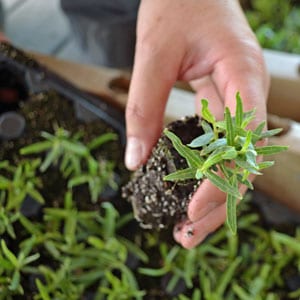

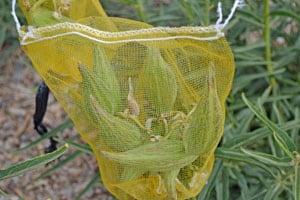


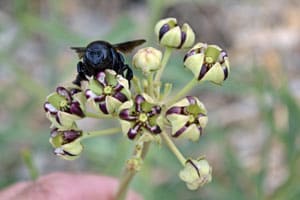
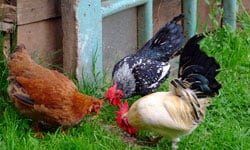
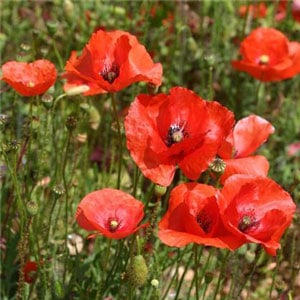



Could I save seeds from wild milkweed here in Ohio? There were lots of Monarchs when I was a child. Not many now. I’ve only seen one this summer.
Hello Mary Jane! Yes you can save milkweed seeds, as they are all “wild” – there are really no domesticated varieties. Just save them and replant in the fall to mimic the shattering of the seed pod to replenish the population. Soon you should see more butterflies!
I found your post to be very enjoyable and very informative. I have been reshaping my garden over the past 4 years to attract butterfly’s so I am always looking for information on the subject.
Good to hear, Charlie! Hope we have given you some good info and hopefully inspiration.
Can milkweeds be replanted? I have several patches of volunteers in my yard/lawn that I would like to move.
John, I’m not sure if they will survive the transplant, but you should try if the alternative is to kill or remove them. Depending on the size of the plants and roots, dig deeply and widely to preserve as much of the root structure as possible. The transplant hole should be about 1 1/2 times the size of the root ball, line it with a rich well-rotted compost, add the root ball and fill the rest of the hole with more compost. This will provide a good amount of nutrition to keep the plant alive until it can re-establish itself. Good luck and let us know how it goes!
Is it legal for me to just go all over the place planting these seeds?
There’s a swampy area behind my neighborhood that I’d LOVE to turn into a Monarch Waystation! =)
Brian, I can’t speak for any legal ramifications, as today’s legal code is so convoluted as to be unfathomable even by highly trained attorneys, but milkweed does send seeds out on the wind, so have at it! Please let us know how the plantings turn out.
Stephen, is there a way to encourage a small milkweed patch that I already have? Should I add compost to the soil surrounding the plant? It’s not very big but it did send its seeds out just a week or so ago.
I would scatter the seed that is produced to increase the plant population in the patch. Milkweed will grow very well in marginal soils, as seen by the amount that grows along country roadsides, so doesn’t need much in the way of care or fertilizers.
Dear Stephen and Cindy,
First I want to express my sincerest gratitude for your interest in and efforts to do something about the dwindling monarch populations, engaging and educating others in the process. I extend the same gratitude to Brianna Borders and all those at the Xerces Society, for getting the ball rolling and supplying a means to get started. And a heartfelt thanks and amen to all those at Painted Lady Vineyard, Fiona Reid and Jodi Padgett, as well the entire volunteer crew, who expended precious time, resources and effort to keep the ball rolling; supporting and bringing to fruition this massive and noble project that crosses species barriers and demonstrates “the most selfless act of extending care and loving kindness to all sentient beings” Dahlai Lama
Though habitat destruction is a major force in the current trends on Monarch populations, there is plenty of potential “Monarch real estate” in backyards, urban community gardens ( organic of course) urban open space and botanic gardens to provide sufficient refuge for existing populations to flourish ( and perhaps grow) until we (the collective WE) come to our senses. Commercial, government sanctioned, chemical and biological warfare against the incredible diversity of native plants and animals that inhabit our world is a senseless act of depravity against humans as well.
Feeling helpless to counteract corporate control of our food, water and energy supplies is an illusion. Planting butterfly and pollinator habitat gardens, organic local food production (at home, in our yards or patio container, or in local organic community garden and through CSA shares) are extremely effective measures to counteract this alarming trend mass food production and transport. Harvesting rainwater (using swales, organic matter and direct drip irrigation attached to a gutters are legal in Colorado where water law prohibits storage methods like rain barrels) and recycling organic matter, headed for the landfill, into rich compost, to feed and stabilize poor or dry soils, are reasonable methods for the more ambitious eco-warrior to provide a lasting legacy for future generations, by keeping our food supply local, sustainable and independently controlled ecologically wise
Permaculture, with its emphasis on sustainable, low maintenance, ecosystem-focused approaches to growing food, places a high priority on preserving surrounding ecosystems and using some locally adapted native plants as potential, highly nutritious food sources, as well as more familiar fruits and veggies. Doing what you can to help our home planet flourish as the paradise it once was and still can be, for all life, is a noble practice.
I’m on my way out to check on my native plant transplants and sow more milkweed, penstamon, hummingbird mint etc… that is after I order a few packets of Terroir seeds. Do you think it’s worthwhile to include Asclepias asperula in my Zone 6 Colorado habitat garden? I promise to provide winter protection. You never know, they may result in a cross with Asclepias tuberosa that has great drought tolerance and enough hardiness to survive further north. Thank you again, for being there!
Namaste, Barbara
Thanks for the kind words Barbara, we appreciate them! I would give the “asperula” species a try. It is native to much of the western US, but is not commercially available because it isn’t as easy to grow as others. Please let us know how it does for you if you do try it!
Hi Stephen – I would like to buy organic butterfly milkweed seeds to sell at our retail nursery in the Hamptons, NY. Do you have a recommendation where I can buy them … and ideally at wholesale so that I do not have to charge my customers too much.
Thanks much!
Tom, we do have the Spider Milkweed in bulk, contact me by email for the pricing.
Any recommendations for a backyard grower? I’m in zone 7b, pretty heavy tree canopy and currently drought conditions (California).
I have a small property and would like to work some milkweed in for the same reasons as you have done, but since it’s a small property (1/4 acre including the house) we could only do a small patch. Do you happen to know what might be more shade tolerant while being relatively drought tolerant?
Our landscaping is likely the bane of our neighborhood, we’re passionate about bees so our backyard is all clover we allow to go to flower and do not do any herbicides or pesticides. A patch of milkweed would fit right in to our local nuisance, haha. :) I only say it’s a nuisance because 2 of our neighbors are sod lawns, and I’m sure our pesky seed drifts drive them nuts.
Every little bit helps, Pam! There are several different species of milkweed that the Monarchs use, but I am only familiar with what we have helped with growing out – the Spider or Antelope Milkweed. They are native across the western US, so should work well for you. They are partially shade tolerant and will acclimatize to dry conditions once established. You could always plant them along the borders of fencing, as there is more moisture available there from the harvesting effect of fences.
I am interested in buying/growing milkweed in my backyard. Butterflies have always been a very special part of my life. I have miscarried twice and am always surrounded by butterflies no matter where I go. So they are very symbolic and make me really happy every time I see one. We had the pleasure to raise to 2 butterflies from the caterpillar stage and it was amazing. We just released one of them today and I wished I had milkweed so they might stick around for longer. I live in AZ so it is very hot and is hard to find milkweed here. Do you know where I can buy it and what kind would be ok to survive in AZ? Thank you very much and I really appreciate all the amazing work you do! Take care
Sara, there is this small heirloom seed company that just happens to sell the Antelope or Spider Milkweed (Asclepias asperula)! ;) It is grown in Arizona, so it should do well there.
Just bought a milkweed plant at my local Home Depot today and it came with at least 3 small caterpillars already living on it. I wondered though if it was a large enough plant to support the 3 till their metamorphosis. It’s about 2ft tall with 5 branches in a 1 gallon pot. Each branch looks to have an average of a dozen large leaves with a few new ones sprouting at the tops with flowers. Will the caterpillars end up killing the plant?
I am interested in seeding my property in Down East Maine with native milkweed. My plan is
to stake out open mature seed pods on 3′ stakes. I have 40 acres in a remote area. I would like the seeding to occur naturally.
How would I go about getting mature milkweed pods that are native to my area.
A reply is sincerely requested.
Alex
Alex, I would look for milkweed that is ripening in your area, collect some of the pods and grow the seed out. Make sure that you have permission to collect the pods, as some private and public properties are ok with wildflower collection but want to monitor how much is collected.
Another resource is Monarch Watch which lists vendors along with milkweed types and regions where they grow. They welcome inquiries about larger projects just like yours!
It’s hard to say, Elena. It depends on how fast the plant grows in relation to how fast the caterpillars eat the leaves.
Can you transplant plant milkweed plants at this time of year? we are at 4,200 feet, we can get hefty winter freezes. would the roots survive?
I would not try to transplant at this time of year, Laura. Waiting until next spring when things start warming up would be less of a shock to the roots and system. Milkweed does best as a transplant when young and not more than 6 months old. If it is older than that, start with new seeds or seedlings.